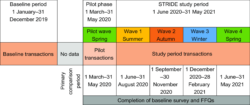Could supermarket loyalty cards reveal how our diets measure up?

The potential for supermarket transaction data to contribute to dietary research is becoming increasingly recognised. But just how well do purchase records represent the diets of individuals and what can they tell us about dietary behaviours at a population-level?
Thanks to secure data infrastructure and investment in partnerships at the Leeds Institute for Data Analytics, researchers at the University of Leeds have worked with a large national retailer to explore these questions in a novel validation study, Supermarket Transaction Records In Dietary Evaluation (STRIDE).
The STRIDE study was led by Dr Vicki Jenneson, a graduate from the first cohort of the ESRC Data Analytics and Society Centre for Doctoral Training, in which the University of Leeds is a partner. During Vicki’s PhD, she partnered with a large UK supermarket and recruited customers from their loyalty card scheme, to better understand how well transaction records reflect what people report to consume.
National dietary surveys, such as the UK’s National Diet and Nutrition Survey (NDNS) can reveal important dietary trends, but the costs and administrative burdens associated with surveys limit their sample sizes and temporal granularity. Online food records and digital surveys improve scalability and reduce costs, but they continue to rely on self-report which is known to exhibit social desirability and recall biases leading to under-estimation of energy intake.
The STRIDE study responds to calls for nutrition researchers to harness new technologies which could provide a suite of scalable objective dietary assessment methods. For some time, researchers have collected paper till receipts and asked participants to complete purchase diaries. Now, advancements in technology and data storage mean that Electronic Point of Sale (EPOS) data are recorded every time we shop, creating a digital footprint of food purchases with the potential for use in research. Traditionally used commercially for stock analysis, customer segmentation (e.g. regular purchases of nappies and infant formula would be indicative of a young family) and marketing, EPOS data in combination with product nutritional information and customer data, could provide objective large scale population-level dietary insight.
The STRIDE study compared dietary estimates from supermarket transactions with an online Food Frequency Questionnaire (FFQ) in a sample of 686 consenting loyalty card holders from four regions in England.
The study protocol was registered prior to starting the study on the Open Science Framework.
Eligible customers (aged 18+) were contacted via email by the retailer and invited to participate. All customers who completed the study were entered into a series of prize draws for a chance to win a £75 high-street voucher, as an incentive to take part.
Participants were recruited in four waves, accounting for seasonal dietary variation. Purchases were collected for 1 year during and 1 year prior to the study. The Bland–Altman statistical test was used to assess how well purchases agreed with self-reported intake for daily estimates of energy and 5 key nutrients: sugar, fat, saturated fat, protein and sodium (both absolute amounts and relative to total energy).

Fig. 1 STRIDE study design. STRIDE, Supermarket Transaction Records In Dietary Evaluation
Recruitment figures for the STRIDE study are shown in Table 1

Table 1 STRIDE participant recruitment summary
This STRIDE study offers a unique dataset for comparing dietary estimates from purchase records with self-reported consumption. In our analysis sample, which comprised mostly of affluent older females, we observed huge variation in how well purchase and intake estimates aligned. Where people purchased smaller amounts from the retailer purchases significantly under-estimated intake, while for large purchase amounts (suggesting that food is shared among a household or more widely) nutrient intakes were significantly over-estimated.
Overall, absolute purchase values (be they at the household or individual level) were found to be a poor proxy for individual intake, meaning purchase records do not accurately reflect the amount of each nutrient someone consumes in a day. This is perhaps unsurprising, given that people obtain food for a range of sources, including from other supermarkets, independent retailers, cafés and restaurants, and home-growing. However, agreement was found to be stronger for smaller households and among the most loyal customers, suggesting that more accurate estimates could be obtained through careful sampling.
When nutrient estimates were expressed relative to total energy (e.g. the percentage of total energy contributed by fat), purchases represented dietary composition fairly well (particularly for sugar and saturated fat). This suggests that purchases are a pretty good marker of dietary intake pattern. This knowledge means that purchase data could have applications for selecting study samples and for assessing population dietary quality, in relation to the UK’s Eatwell Guide recommendations for example.
The STRIDE study contributes to evidence for the validity of purchase records as a proxy for dietary intake. To our knowledge, STRIDE is the first study to quantify the statistical agreement and limits to agreement between actual and relative nutrient estimates from automated electronic purchase data and self-reported intake.
Authors:
Becky Shute and
